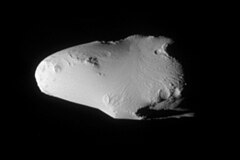Kalipso (księżyc)
| ||
 Kalipso widziana przez kamerę sondy Cassini (13 lutego 2010) | ||
| Planeta | Saturn | |
|---|---|---|
| Odkrywca | D. Pascu, K. Seidelmann, W. Baum i D. Currie | |
| Data odkrycia | 13 marca 1980 | |
| Tymczasowe oznaczenie | S/1980 S 25 | |
| Charakterystyka orbity | ||
| Półoś wielka | 294 721 km[1] | |
| Mimośród | 0,0005[1] | |
| Okres obiegu | 1,888 d[1] | |
| Nachylenie do płaszczyzny Laplace’a | 1,500°[1] | |
| Długość węzła wstępującego | 314,226°[1] | |
| Argument perycentrum | 17,470°[1] | |
| Anomalia średnia | 156,660°[1] | |
| Własności fizyczne | ||
| Wymiary | 30 × 23 × 14 km | |
| Okres obrotu wokół własnej osi | synchroniczny | |
| Albedo | 1,34 ± 0,10 | |
| Jasność obserwowana (z Ziemi) | 18,5m | |
Kalipso (Saturn XIV) – księżyc Saturna, odkryty przez D. Pascu, K. Seidelmanna, W. Bauma i D. Currie w 1980 roku, z naziemnego obserwatorium.
Nazwa pochodzi od nimfy Kalipso, postaci z mitologii greckiej. Kalipso krąży w odległości około 295 tysięcy kilometrów od Saturna, w obrębie pierścienia E. Porusza się po tej samej orbicie, co dużo masywniejsza Tetyda, w punkcie Lagrange’a L5 na orbicie tego księżyca, jest więc tzw. księżycem trojańskim.
Zobacz też
- chronologiczny wykaz odkryć planet, planet karłowatych i ich księżyców w Układzie Słonecznym
- księżyce Saturna – zestawienie podstawowych danych
Przypisy
Linki zewnętrzne
- Calypso (ang.). W: Solar System Exploration [on-line]. NASA. [dostęp 2018-12-26].
Media użyte na tej stronie
This is a revised version of Solar_System_XXIX.png.
Saturn Cassini-Huygens (NASA)
Instrument: Imaging Science Subsystem - Narrow Angle
Saturn's peaceful beauty invites the Cassini spacecraft for a closer look in this natural color view, taken during the spacecraft's approach to the planet. By this point in the approach sequence, Saturn was large enough that two narrow angle camera images were required to capture an end-to-end view of the planet, its delicate rings and several of its icy moons. The composite is made entire from these two images.
Moons visible in this mosaic: Epimetheus (116 kilometers, 72 miles across), Pandora (84 kilometers, 52 miles across) and Mimas (398 kilometers, 247 miles across) at left of Saturn; Prometheus (102 kilometers, 63 miles across), Janus (181 kilometers, 113 miles across) and Enceladus (499 kilometers, 310 miles across) at right of Saturn.
The images were taken on May 7, 2004 from a distance of 28.2 million kilometers (17.6 million miles) from Saturn. The image scale is 169 kilometers (105 miles) per pixel. Moons in the image have been brightened for visibility.
The Cassini-Huygens mission is a cooperative project of NASA, the European Space Agency and the Italian Space Agency. The Jet Propulsion Laboratory, a division of the California Institute of Technology in Pasadena, manages the Cassini-Huygens mission for NASA's Office of Space Science, Washington, D.C. The Cassini orbiter and its two onboard cameras, were designed, developed and assembled at JPL. The imaging team is based at the Space Science Institute, Boulder, Colo.
For more information, about the Cassini-Huygens mission visit, http://saturn.jpl.nasa.gov and the Cassini imaging team home page, http://ciclops.org.Cassini's narrow-angle camera image of Calypso taken on February 13th 2010. The image has been enlarged by a factor of 2 and sharpened. The view was aquired at a distance of 21 360 km from the moon and the original image scale was 128 meters per pixel.


